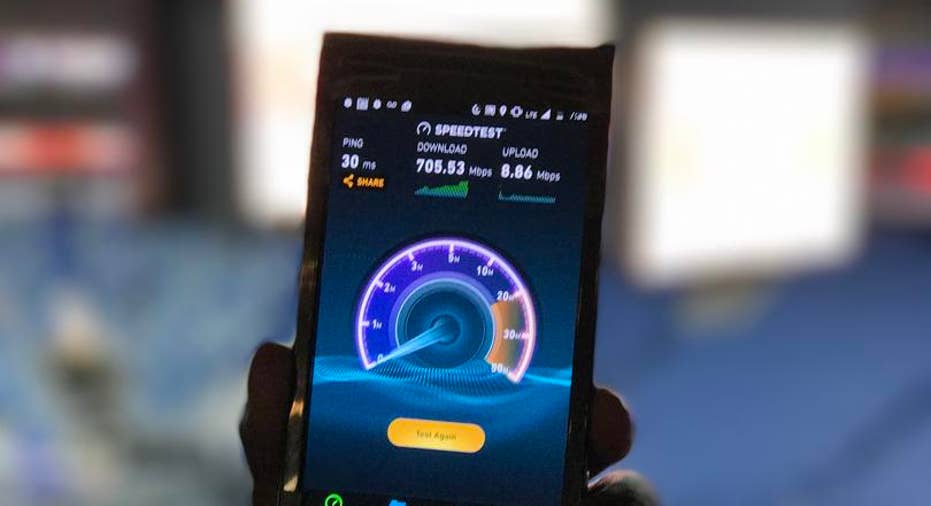Sprint Shows Off New Moto Phone, Gigabit LTE

Sprint showed off amazing speeds of 700Mbps down on its live LTE network during a basketball game in New Orleans last night, and teased a new high-end Motorola phone that will be one of the first to access Sprint's highest-speed system.
The demo came at the ridiculously named Smoothie King Center in New Orleans, where thousands of basketball fans went about their evenings not knowing that Sprint had massively boosted capacity.
"A lot more customers can, in parallel, receive high-def content" with the system upgrade, Sprint technical COO Guenther Ottendorfer said.
Several pieces must fall in place before you feel these speeds yourself. First, Sprint has to upgrade its base stations with 3x carrier aggregation and a coding scheme called 256 QAM. 3xCA is in 100 cities already, Sprint CTO John Saw said.
But you'll also need a phone with a gigabit modem and eight antennas tuned to Sprint's 2.5GHz band, and those don't exist yet. Sprint will push to make these features standard on major global and unlocked phones, Sprint VP of product development Ryan Sullivan said, but it sounded like it may take the rest of the year for it to become common.
According to rumors, the "secret" Moto phone, probably the next Moto Z, likely won't arrive before June. If it's the earliest phone supporting the new capabilities, that means the LG G6 and Samsung Galaxy S8 will be left out of the gigabit party this year. All we really know about the new Moto is that it will have a Qualcomm Snapdragon 835 processor and the gigabit abilities.
(For what it's worth: the G6 doesn't have a gigabit modem, and while the S8 will, it may not have the appropriate antennas for Sprint's maximum speeds.)
Will Sprint Vault to First Place?
This Sprint launch could make it the fastest carrier in cities where it's implemented. Looking at data from Ookla's Speedtest Intelligence portal, we see that Sprint's mean LTE speed in the city of New Orleans vaulted from 21.55Mbps in February to 62.63Mbps in March. That big jump in average speeds may be because of those 700Mbps results last night, as a few high results can skew an average.
But Sprint execs emphasized that the move to gigabit isn't actually about peak speeds. It's about capacity, making Sprint able to provide a more consistent service. Gigabit will combine with another new Sprint technology, HPUE, which has already appeared on the LG G6, to improve the performance at the edges of notoriously small 2.5GHz cells. It'll make the system feel like more of a blanket and less of a hotspot.
Median, rather than average speeds, can show the most common experience. In March in New Orleans, Sprint's median speed also shot up, from 5.47 to 16.16Mbps. That's on par with Verizon, coming from a February result where Sprint was in a very weak fourth place.
"It's not so much about peak speeds. We know we're going to bring a lot of capacity tonight, and a lot of people with phones will have a very good experience," CTO Saw said.
What About T-Mobile?
T-Mobile has said that it will be first with gigabit LTE in the US, but right now, Sprint is looking closer. T-Mobile hasn't given any solid dates for its gigabit LTE rollout, just saying that it's coming later this year. But the Galaxy S8 may be compatible with T-Mobile's system because of its antenna layout.
The path to gigabit is easiest for Sprint because it has a huge swath of clear spectrum in the 2.5GHz band. Other carriers need to patch together gigabit speeds by merging disparate lanes of spectrum (and in some cases, borrowing Wi-Fi airwaves). Sprint can just widen its use of 2.5GHz. But it's a little harder for Sprint to get phones for its network because its spectrum band is unique in North America. T-Mobile shares an LTE band with Verizon, AT&T, and several Canadian and Latin American carriers.
Sprint continues to turn on 3xCA and the other gigabit-ready features in various cities. LA and Phoenix were upgraded today, Saw said. Major high-end smartphones including the Galaxy S7 and LG G5 will be able to take advantage of faster, if not gigabit, speeds with the network upgrades for now, and when gigabit phones come, the network will be waiting for them, he said.
"When the phones become ready, I think the network will be ready to support these capabilities," Saw said.
This article originally appeared on PCMag.com.